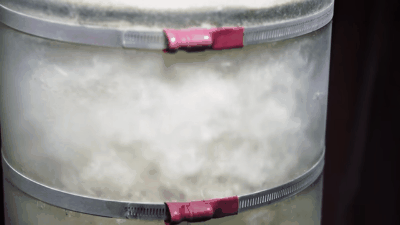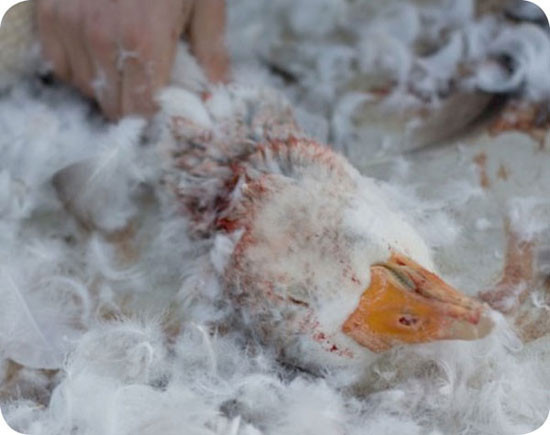The dark truth behind the warm winter fur coat
Those who do not like to wear feathers. Light and warm, trendy too. But the truth behind it probably will make many people think a lot.
has long been an indispensable warm-keeping solution for humans. Soft, warm, trendy and foldable, it's no surprise that this kind of shirt has become so popular.

Fur coats have long been an indispensable warm-keeping solution for humans.
Basically, feather jackets have 2 types: natural and artificial fur . The natural type is more expensive because of its high cost, limited quantity, but soft and warm so it is preferred.
The production of a feather coat needs to go through many stages relatively difficult. The most complicated is that it is not just a large shirt, but is assembled from many pieces together. They could understand simply that they made a jacket, and then made another one outside.

The most important thing of a feather coat is fur.
The most important thing of a feather coat is fur . The feathers used to make shirts are fluff - fur has too many great advantages: light weight, moderate weight and area, long life, and possesses the best ability to keep warm in the world. .
However, it is these wonderful hairs that hide the extremely dark side of the back. It is about collecting feathers.
Nightmare of waterfowl
People often take fur in 3 methods.The first is peeling after death - the method is rated as "humanistic" the most. People kill geese or ducks that are raised for meat, then dipped in hot water and then preen easily ( either by hand, or by machine ).

Goose is caught by the neck, clamped hard, then any suitable hair will be pulled out .
However, this method has many drawbacks, such as hair reduction in durability, and depends entirely on the livestock industry for eggs and meat. Therefore, many goose breeding sites decided to implement the second method, also the nightmare most opposed: living.
As the name suggests, the goose is grabbed by the neck, clamped hard, then any suitable hair will be pulled out, without any anesthesia or anesthesia method. People often target the hair on the chest, back, under the wings and neck. Those are the best quality fur areas, and of course the most expensive.

Turn your feathers off when geese are still alive.
Their skin blisters, bleeding, while the throat sounds very pathetic. The large pieces of broken skin will be sewn directly with a needle, and of course there is no need to sterilize or numb at all.
The advantage of this method is that geese will be . reused after preening. They were thrown to the floor, dragged, red, but survived. After about 6 to 7 weeks, the puckering process takes place again, before they are put on the slaughterhouse (or die of stress and pain).


Goose after being hairy.
Finally the "pick up" method . During maturation, waterfowl species will undergo molting. It will take advantage of this to obtain the proper fluff that has fallen off.
It may sound gentle, but in practice, this method is usually done on hundreds of children at once. Even if all geese are in the same molting period (though never happen in reality), there are uneven hair growths, and are scattered throughout the body. So, in fact, they still "live" in a very "unintentional" way.
In addition, the actions of catching, holding, and pinching all affect the psychology of geese, not to mention the risk of subsequent fractures or deformities.
Where's the feather in the fashion industry?
Most representatives of fashion firms insist that feathers and other hairs are taken after the geese die. This means, feathers are a by-product "not taken, they are still there" of the meat-raising industry.

Most representatives of fashion firms insist that feathers and other hairs are taken after the geese die.
But this seems like just "reassuring" consumers. In February 2009, a report in Sweden revealed the fact that 50% - 80% of feathers on the market came from living creatures. That is why IKEA (Swedish furniture company) immediately stopped importing feathers from China at that time (China is one of the countries with the largest feather market in the world).
According to the European Feather Association, there are currently only 2% of feathers on the market due to "live furry" , while the remaining 98% comes from the food industry. However, according to Marcus Mueller, a researcher from an animal organization, that number is not as optimistic as we imagined.
"Only geese are living, but they talk about the industry as a whole - that is to include billions of ducks in the world that don't have that kind of furry."
"That means if only counting goose numbers, the number will be very huge."
In fact, even enterprises that claim not to use live hair removal methods cannot guarantee 100%.

Only geese are hairy.
"Manufacturers cannot guarantee whether the supply of feathers is really good for pets. It is impossible."
Should or should not buy fur coat?
We cannot say we should boycott the feather coat, because most of the current coat is a by-product of the breeding process. Moreover, the fur coat is really warm, most luxurious and trendy, so it is extremely popular.
The problem is only in management and production. Managers need to take a more specific action, to control the "humanitarian" nature of feather supply facilities (such as asking for a quality inspection stamp).
But besides, many people believe that no matter what method the feathers take, the fate of the furry creature is also death, and if so, there is no humanity here. Moreover, there are many other artificial materials that have the ability to keep warm completely inferior to feathers, so why not use it?
What do you think about this issue? Please leave a comment.
- Keep babies warm in the winter
- How to keep your body warm in winter
- These teas help keep the body warm in winter
- The secret to fighting colds effectively in winter
- 7 ways to keep your body healthy
- The winter is unusually warm in northern Europe
- The recipe keeps warm with 3 coats even when it is snowing
- Foods that keep your body warm in the winter
- 'Online love' of netizens
- The jacket is made of fur ... men's breasts
- Russia: life is disturbed by the warm winter
- Warm tile roof in winter, cool in summer
 'Fine laughs' - Scary and painful torture in ancient times
'Fine laughs' - Scary and painful torture in ancient times The sequence of numbers 142857 of the Egyptian pyramids is known as the strangest number in the world - Why?
The sequence of numbers 142857 of the Egyptian pyramids is known as the strangest number in the world - Why? History of the iron
History of the iron What is alum?
What is alum?